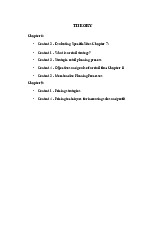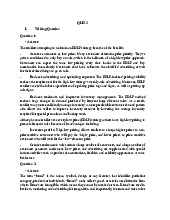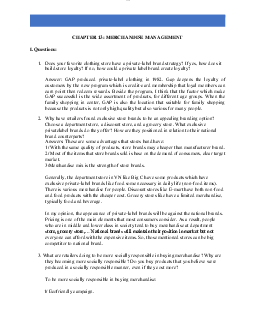









Preview text:
lOMoAR cPSD| 58097008 Retail Management Exam 1 Study Guide Jackie Ortiz
Chapter 1: Intro to Retailing List of Retailers:
- Hannaford, American Apparel, Target, Walmart, Amazon.com, QVC, Hilton, Red Box, hair salons, airlines What is retailing?
A set of business activities involved in adding value to the goods/services sold to ultimate consumers What is a retailer?
A business that adds value to the goods/services sold to ultimate consumers
Example: Red Box adds the value of convenience by using a simple kiosk Scope of Retailing
Walmart ---------------------------------------------------------------------- Red Box - Huge, global retailer - Merely a small kiosk - Ex. Macy’s, Best Buy - Ex. Fashion boutique - Undertakes all traditional - Focuses on buying & Business activities Selling goods
Supply Chain/Channel of Distribution
MANUFACTURER WHOLESALER RETAILER FINAL CONSUMER
Vertical Integration: when a company/business acts as more than one position in supply chain
Example: American Apparel
They produce their own clothing locally, distribute it locally and sell it
locally as well all under their own business
Backward Integration: either a retailer or wholesaler working with a wholesaler or a manufacturer lOMoAR cPSD| 58097008
Forward Integration: either a manufacturer or wholesaler working with a wholesaler or a retailer
MANUFACTURER WHOLESALER RETAILER CONSUMER
Ralph Lauren BJ’s Wal-Mart Levi’s Sam’s Club Target
Ralph Lauren and Levi’s have their own retail stores as well
MANUFACTURER RETAIL = FORWARD INTEGRATION
BJ’s and Sam’s Club have consumers that go directly to their store for food
WHOLESALER CONSUMER = FORWARD INTEGRATION
WalMart doesn’t need wholesalers so they buy straight from manufacturer
RETAILER MANUFACTURER = BACKWARD INTEGRATION What do retailers do?
- Retailers add value to their product o Ex. If I purchase a t-shirt from a
manufacturer, it will probably be around
$7. Whereas if I purchase it from American Apparel, it has been marked
up and also has the brand name on it. Therefore, the retailer has added value to the product.
- Wholesalers and retailers add value and offer convenience to consumer
How do retailers increase the value of their products? (Roles of Retailers)
(1) Holding inventory for the consumers (the store acts as a warehouse)
(2) Providing assortment (buying multiple different items in the same place)
(3) Breaking bulk (retailers break up product from bulk packages from wholesalers
and sell it individually to consumers)
(4) Provide services (consumers can examine the product, pay with credit, get information about product) Why study retailing? - Huge impact on economy
o US retail stores represent 1/3 of total economy
- Major source of jobs o 1 in 5 US workers is employed by retailers
- Rising retailer power in supply chain o Manufacturer used to hold power, now retailer does lOMoAR cPSD| 58097008
- Implications for fashion business (Fashion sector is 1/3 of US retail
stores) Chapter 2: Types of Retailers Retail Mix Elements:
1. Merchandise (variety/assortment)
a. Variety: broad vs. narrow
a.i. The number of merchandise categories (ex. Computers, dress, motorcycles, makeup)
b. Assortment: deep vs. shallow b.i.
The number of items in a category; SKU – stock keeping unit
(ex. Selling cellphones but having iPhones, droids, flip phones) 2. Services Offered 3. Retail Pricing 4. Ambience 5. Location
Example: Retail Mix- Supermarket
1. Merchandise: extensive width and depth of assortment; average quality; private and generic brands
2. Atmosphere and services: Average 3. Prices: competitive 4. Location: neighborhood
5. Promotion: heavy use of newspapers, flyers and coupons Food Retailers Channel Preference
1. Conventional Supermarket (Shoprite, Hannaford) 2. Supercenter (Wal-Mart)
3. Warehouse (Sam’s, BJ’s)
1. Supermarkets (most preferred)
A large, self-service retail food store offering groceries, food, and some non-food items
Limited Assortment Supermarkets: extreme value food retailers Ex. Aldi German retailer
Issues in Supermarket Retailing: lOMoAR cPSD| 58097008
Competition from low-price stores (efficient distribution, low prices and cost)
Competing formats: Supercenters, warehouse clubs, convenience stores Supermarket Survival Pack - Emphasize fresh perishables
- Target health conscious and ethnic customers
- Offer more private label brands
- Provide a better in-store experience 2. Supercenters
A large store that combines a supermarket with a full-line discount store
Hypermarket: concept originated from France; focus more on freshness
and have large portions of food Issues in Supercenters:
Fastest growing retail category
One stop shopping experience Challenges in finding location
Backlash against large retail stores
• Drive local retailers out of business • Offer low wages • Provide non-union jobs
• Have unfair labor practice 3. Convenience Stores
Provide a limited variety/assortment of merchandise at convenient
location (Ex. Pilots, Hess, 7 Eleven) Advantages: o Convenience o Long hours
o Availability of both fill-in items and gas Issues in Convenience Stores
Increased competition from other formats • Solutions:
• Try to decrease dependency on gasoline sales
• Tailor assortments to local markets
• Make stores even more convenient to shop in lOMoAR cPSD| 58097008
• Add new services (Café, ATM, sell movie tickets) 4. Warehouse Clubs
A retailer that offers a limited and irregular assortment of food and
general merchandise with little service and low prices
Low prices are possible because: Use low-cost locations
Have inexpensive store designs
Offer little service (salespeople) Sell large quantities
Carry a limited assortment of fast selling items • Keeps inventory costs low
General Merchandise Retailers 1. Department Store
Retailers that carry a broad variety and deep assortment and offer
customer services and organize their stores into distinct departments
Issues in Department Store Retailing: o Competition
Inconvenient location: discount store are big competition
Diminishing customer service: specialty stores competition
Not successful in reducing costs: discount & specialty stores
o What to do with an eroding market
Increase the amount of exclusive merchandise (private label)
Develop strong images for stores and brands (TV ads, etc.) Increase discount sales
Participate in multichannel retailing
2. Full-line Discount Stores
Retailer that offers a broad variety of merchandise, limited services and low prices
Only Big 2 left: Wal-Mart and Target/Wal-Mart becoming supercenter
Competition from Category Specialists/Killers lOMoAR cPSD| 58097008 3. Specialty Stores
A retailer that concentrates on a limited number of merchandise
categories with high level of service
o Offers deep assortment but narrow variety 4. Drugstores
Specialty stores that concentrate on health and personal grooming merchandise
o Competition from pharmacies in discount stores
Ex. Walgreens inside a Wal-Mart o Strategies against competition:
Provide more products (ex. Groceries)
Provide more services (ex. Health care assistant)
5. Category Specialist/Killer
Big box store that provides narrow but deep assortment of merchandise
Ex. Staples, Best Buy, Home Depot o These retailers are so big that
they can wholesale to business customers and retail to consumers
6. Extreme-Value Retailer
Small discount stores that offer a limited merchandise assortment at very low prices 7. Off-Price Retailer
Offers inconsistent assortment of brand-name merchandise at significantly low prices
Ex. TJ Maxx, Burlington, overstock.com o Outlet stores
o Opportunistic buying (how they get their product from other stores) Production overruns Canceled orders Forecasting mistakes Close-outs Irregulars Service Retailers Merchandise/Service Continuum lOMoAR cPSD| 58097008
Wholesale club – Supermarket – Category specialist – specialty store – optical center –
restaurant – airline – bank/university
*Wholesale is all goods/no service
*Banks are all service/no goods
Characteristics of Service Retailing 1. Intangibility
a. Hard for customers to evaluate a service beforehand
b. Hard for large company to control service quality as opposed to product quality
2. Simultaneous Production & Delivery
a. No second chance given to service retailers
b. Difficult to reduce costs through mass production 3. Perishability
a. Retailers must match supply & demand (ex. Airline seats, hotel rooms)
a.i. Why? Service retailers have capacity constraint and demand for service varies over time
b. Use programs to match demand and supply (ex. Prices, hours, staffing)
(ex. Prices: movie tickets may be more expensive at night when people go to the movies more)
4. Inconsistency of the Offering
a. Providing consistent high quality is challenging Retailers by Ownership Types: - Independent - Corporate - Franchise Franchising
- More than 40% of US retail sales
- Franchisee pays fixed fee plus a royalty (% of all sales)
- Franchise contract o Franchisor: provide assistance in locating/building store,
developing the product/service, training managers, ads
o Franchisee: operates the store in accordance with procedures prescribed by the franchisor lOMoAR cPSD| 58097008 Franchisor Franchisee Advantages - Rapid expansion
- Initial services offered by franchisor - Receives royalty - Established proven product - Highly motivated
- Business and technical assistance franchisees do good job - Company owned units - High royalty fees may be more - Mandatory participation in profitable promotional services Disadvantages
Benefits Provided by Store Channel - Browsing - Touching and feeling - Personal service
- Entertainment and social interaction - Immediate gratification - Risk reduction
Benefits Provided by Internet Channel - Convenience - Broad/deep assortments
- Extensive and timely information
- Personalization (vs. personal service) o Live chats
o Product suggestions/recommendations
- Information for solving problems, not just merchandise characteristics o Product reviews o Virtual communities
The Multichannel Retailer
A retailer that sells merchandise or service through more than one channel
Why are retailers using multiple channels?
Consumers can buy what they want, when they want it, wherever they want
Ex. Store, kiosk, catalog, call center, web, phone
“Omnichannel” Retailing
Retailers integrate disparate channels into a single seamless omnichannel experience
Changes in Retailer’s Jobs lOMoAR cPSD| 58097008 Traditional Jobs Omnichannel Stock right products Products Customize products Mass-market ad, promotions Shoppers Awareness
Mobile marketing, social media In-store sales promotions Shoppers Experience Customized promotion, mobile checkout, etc. Summary of Exam 1 Chapter 1
- Retailers add value to goods/services sold to ultimate consumers
- Supply Chain: Manufacturer Wholesaler Retailer Consumer
- Vertical integration (American Apparel) - Four roles of retailers
- US retail stores represent 1/3 of economy and employ 1 in 5 people Chapter 2 - Retail Mix (5 elements) - Food Retailers:
o Supermarkets: most preferred, offer groceries and
nonfood items o Supercenters: combines supermarket with
full-line discount store o Convenience: limited
assortment/connected with gas stations o Warehouse
clubs: irregular assortment, little service, low prices lOMoAR cPSD| 58097008
- General Merchandise Retailers:
o Department store: only retailer with negative sales o
Full-line discount: Wal-Mart and Target o Specialty stores o
Drug stores o Category specialist o Extreme Value o Off- price (TJ maxx)
- Service Retailers o 3 Characteristics that separate them from merchandise retailers:
Intangibility (can’t touch or evaluate the product)
Simultaneous production & delivery (no second chance)
Perishability (match supply & demand/hotel rooms ex.)
Inconsistency of the offering (can’t always provide consistent high quality)
- Retailers by Ownership o Independent o Corporate o Franchise
More than 40% of US retail sales are from franchises
Franchisor helps set up business and train; receives $ from franchisee
Franchisee operates the store, also pays fixed fee and royalty


